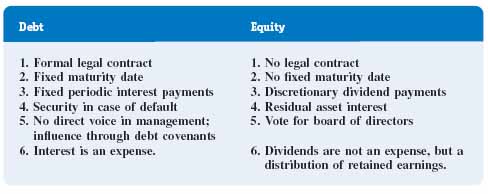DEBT AND EQUITY DISTINGUISHED
Chapters 10 and 11 presented the basic characteristics of the debt contracts between a company and its creditors. This section describes how the nature of this relationship differs from that between a company and its shareholders. As will be discussed later, such a distinction is important to investors, creditors, management, and auditors.
Characteristics of Debt
When a company borrows money, it establishes a relationship with an outside party, a creditor or debtholder, whose influence on the company's operations is defined by a formal legal contract containing a number of specific provisions. These provisions were discussed in Chapters 10 and 11, and they are summarized in Figure 12-3, along with characteristics of equity.
FIGURE 12-3 Characteristics of debt and equity

(Characteristics of Equity
When a corporation raises capital by issuing stock, it establishes a relationship with an owner, often referred to as an equity holder, or shareholder. Unlike debt, an equity relationship is not evidenced by a precisely specified contract. There is no maturity date, because a shareholder is an owner of a company until it ceases operations or until the equity interest is transferred to another party. Dividend payments are at the discretion of the board of directors, and shareholders have no legal right to receive dividends until they are declared. In case of ...
Get Financial Accounting: In an Economic Context now with the O’Reilly learning platform.
O’Reilly members experience books, live events, courses curated by job role, and more from O’Reilly and nearly 200 top publishers.

